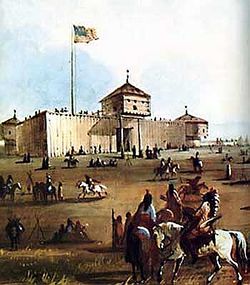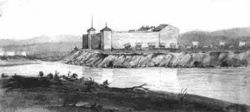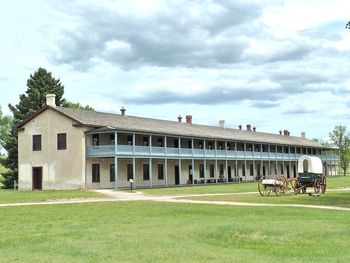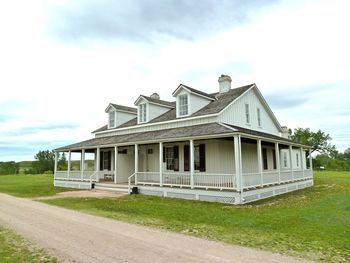Fort Laramie
| More information at Warlike, Wikidata, Wikipedia
History Fort William (1834-1841) In 1834 William Sublett and Robert Campbell, traders operating out of St. Louis, built Fort William (2), the first structure to be located near the junction of the Laramie and North Platte Rivers. The post quickly became important as a base of operation for traders and trappers. The fort was sold to Jim Bridger, William Fitzpatrick, and Milton Sublette of the American Fur Company in 1835. The appearance of the competitive Fort Platte, coupled with the rotting of log palisades, caused the American Fur Company to abandon Fort William (2) and build a new adobe structure called Fort John, a mile or so farther up Laramie Creek. Fort John (1841-1849) In 1845 Congress authorized the establishment of military posts along the Oregon Trail. By this authority, the United States purchased Fort John in 1849 and built Fort Laramie.
 Fort Laramie (1849-1890) Fort William (2), Fort John, and Fort Laramie were all important stopping off places for the increasing number of travelers along the trails to Oregon and California. The post became an oasis for the westward bound immigrants--the only outpost of civilization for the 800-mile span between Fort Kearny, Nebraska, and Fort Bridger, Wyoming. Historic trails and routes that passed through Fort Laramie included the Oregon Trail, the California Trail, the Mormon Trail, the Bozeman Trail, the Pony Express Route, the Transcontinental telegraph route, and the Deadwood and Cheyenne Stage Route. Fort Laramie also served as headquarters for military campaigns on the northern plains. Great Indian Councils that attempted to bring peace to the land occurred here in 1851 and 1866-68. Unfortunately, campaigns against the Indians of the Northern Plains during the last half of the nineteenth century testified to the ultimate failure of the treaties to maintain peace. Operating from Fort Laramie and neighboring posts, the Army eventually subdued the Sioux, Cheyenne, and other tribes in the area. The fort witnessed the development of the open range cattle industry, the coming of homesteaders, and the settlement of the plains that marked the closing of the frontier. The Army abandoned the fort in 1890 and the buildings and land were auctioned off to the local citizens. More than 50 buildings during this time were moved elsewhere, demolished, or dismantled. Current StatusThe buildings that remain today at Fort Laramie are a result of several individuals homesteading the area and thus forestalling the disappearance of the buildings. In 1927, the Wyoming Historical Landmark Commission focused public attention of the fort and by 1936, the National Park Service representatives showed an interest in preserving Fort Laramie. By Presidential Proclamation of 16 Jul 1938, the fort became Fort Laramie National Historic Monument. It was redesignated a National Historic Site in 1960 when the monument was enlarged by Congress.
Links:
Visited: 3 Jun 2010 Picture Gallery
| |||||||
















